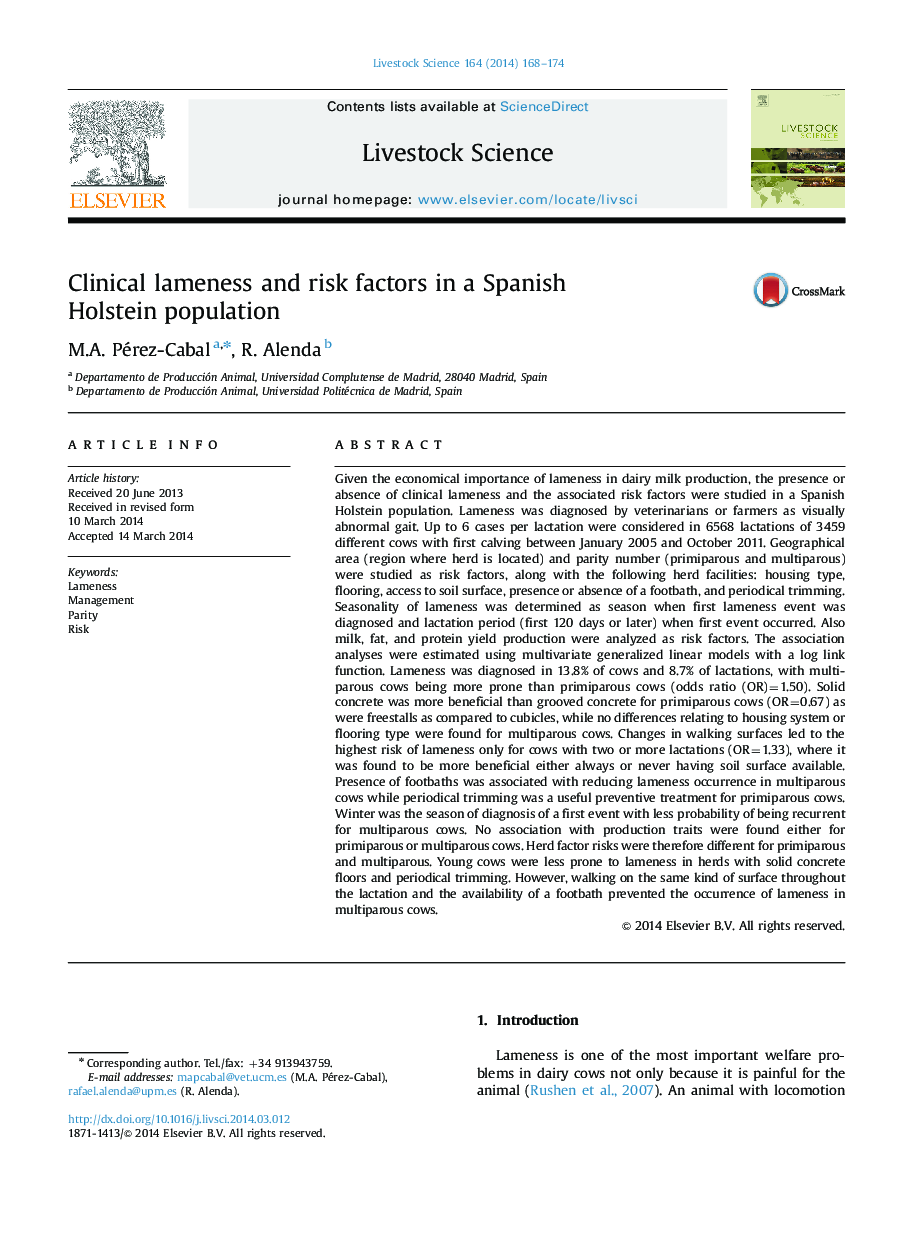| کد مقاله | کد نشریه | سال انتشار | مقاله انگلیسی | نسخه تمام متن |
|---|---|---|---|---|
| 8502266 | 1553968 | 2014 | 7 صفحه PDF | دانلود رایگان |
عنوان انگلیسی مقاله ISI
Clinical lameness and risk factors in a Spanish Holstein population
ترجمه فارسی عنوان
لنزهای بالینی و عوامل خطر در جمعیت هلشتاین اسپانیایی
دانلود مقاله + سفارش ترجمه
دانلود مقاله ISI انگلیسی
رایگان برای ایرانیان
کلمات کلیدی
لنگش، مدیریت، برابری، خطر،
موضوعات مرتبط
علوم زیستی و بیوفناوری
علوم کشاورزی و بیولوژیک
علوم دامی و جانورشناسی
چکیده انگلیسی
Given the economical importance of lameness in dairy milk production, the presence or absence of clinical lameness and the associated risk factors were studied in a Spanish Holstein population. Lameness was diagnosed by veterinarians or farmers as visually abnormal gait. Up to 6 cases per lactation were considered in 6568 lactations of 3459 different cows with first calving between January 2005 and October 2011. Geographical area (region where herd is located) and parity number (primiparous and multiparous) were studied as risk factors, along with the following herd facilities: housing type, flooring, access to soil surface, presence or absence of a footbath, and periodical trimming. Seasonality of lameness was determined as season when first lameness event was diagnosed and lactation period (first 120 days or later) when first event occurred. Also milk, fat, and protein yield production were analyzed as risk factors. The association analyses were estimated using multivariate generalized linear models with a log link function. Lameness was diagnosed in 13.8% of cows and 8.7% of lactations, with multiparous cows being more prone than primiparous cows (odds ratio (OR)=1.50). Solid concrete was more beneficial than grooved concrete for primiparous cows (OR=0.67) as were freestalls as compared to cubicles, while no differences relating to housing system or flooring type were found for multiparous cows. Changes in walking surfaces led to the highest risk of lameness only for cows with two or more lactations (OR=1.33), where it was found to be more beneficial either always or never having soil surface available. Presence of footbaths was associated with reducing lameness occurrence in multiparous cows while periodical trimming was a useful preventive treatment for primiparous cows. Winter was the season of diagnosis of a first event with less probability of being recurrent for multiparous cows. No association with production traits were found either for primiparous or multiparous cows. Herd factor risks were therefore different for primiparous and multiparous. Young cows were less prone to lameness in herds with solid concrete floors and periodical trimming. However, walking on the same kind of surface throughout the lactation and the availability of a footbath prevented the occurrence of lameness in multiparous cows.
ناشر
Database: Elsevier - ScienceDirect (ساینس دایرکت)
Journal: Livestock Science - Volume 164, June 2014, Pages 168-174
Journal: Livestock Science - Volume 164, June 2014, Pages 168-174
نویسندگان
M.A. Pérez-Cabal, R. Alenda,
